Oranmore Castle is no longer listed on Revenue Section 482.

donation
Help me to pay the entrance fee to one of the houses on this website. This site is created purely out of love for the subject and I receive no payment so any donation is appreciated!
€10.00
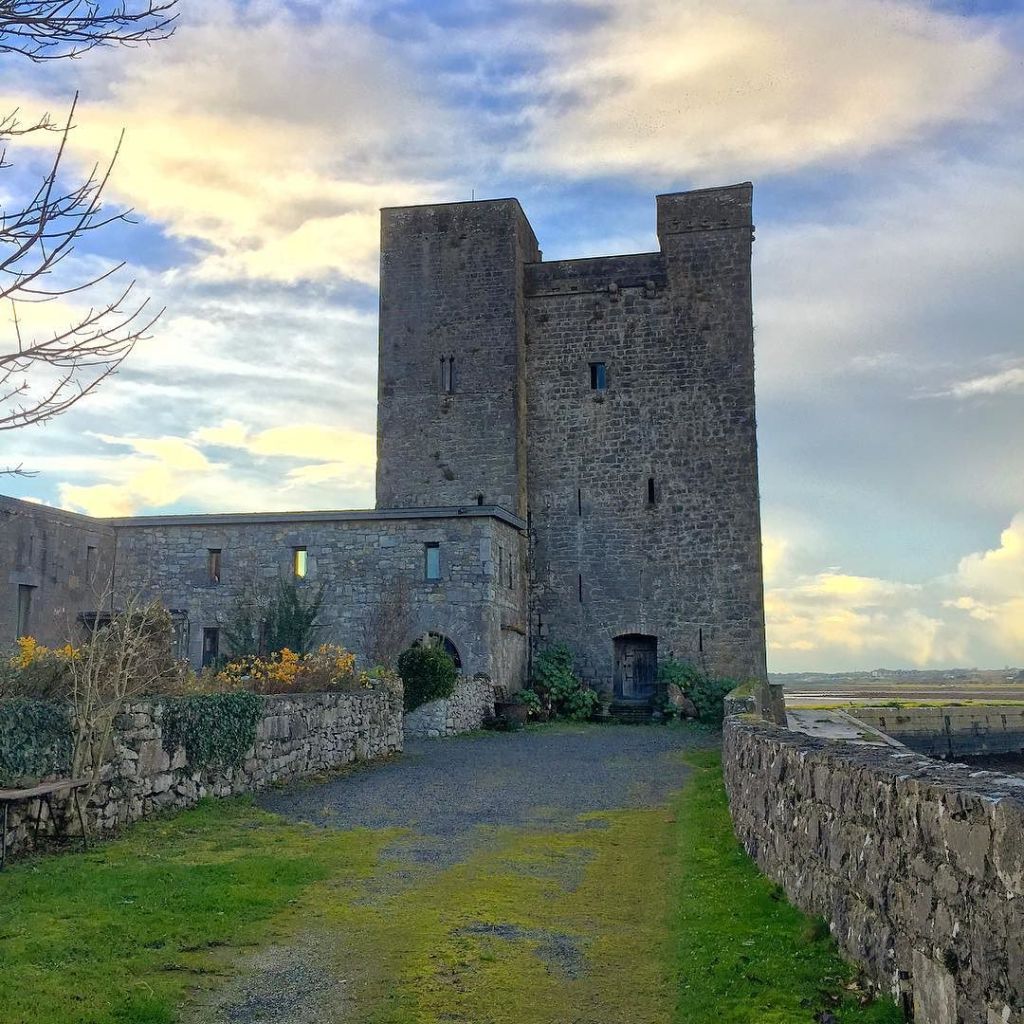
Oranmore Castle is a tall fourteenth or fifteenth century castle on the shore of Galway bay, lapped on two sides by the sea at high tide. The castle contains two very large vaulted halls, but we only saw one of them. It has four storeys, a rectangular tower house with a square staircase turret, and a great hall on the ground floor.
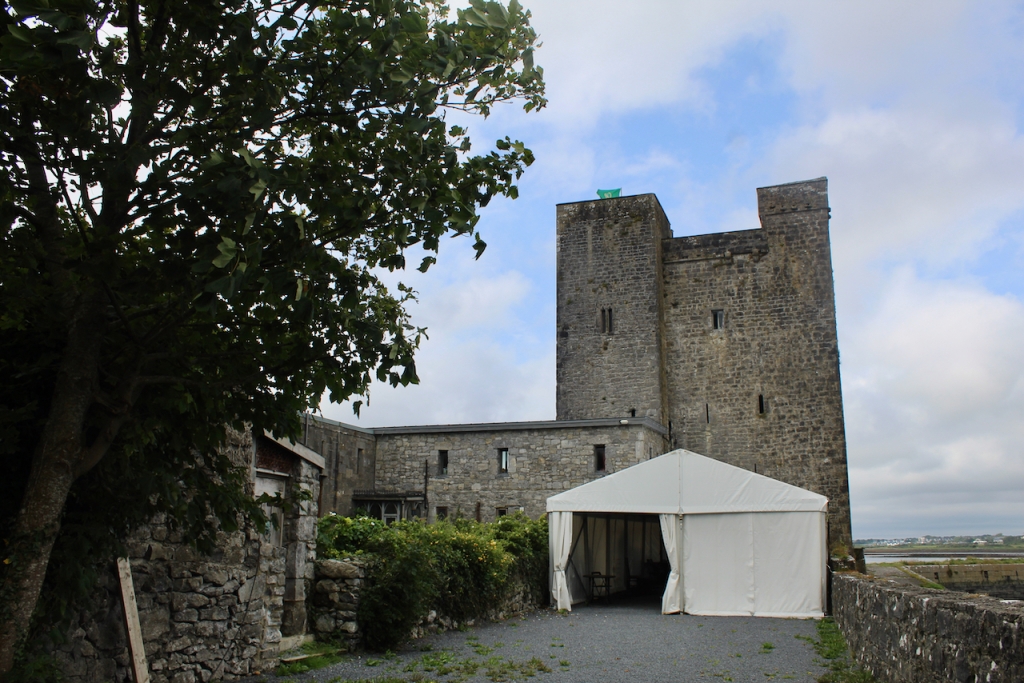
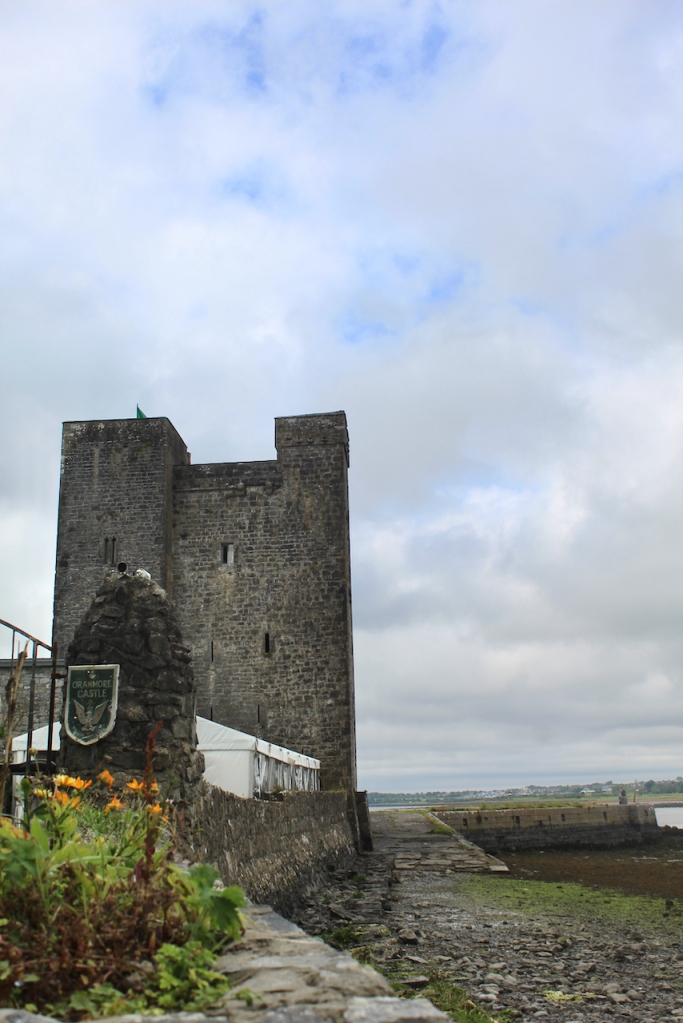
We visited Oranmore Castle during Heritage week in 2022. I was excited to visit it as it belongs to a daughter of Castle Leslie in County Monaghan, another section 482 property which we have visited. Anita Leslie’s mother purchased it for her. At the time of our visit it was inhabited by Anita’s daughter Leonie and her husband Alec, who has since died.
The website welcomes us: “Welcome to Oranmore Castle — an exciting experience, which brings the mystery of the old alive and an eccentricity into the new. Oranmore Castle is a wonderful experience for people of all ages. Whether you come just to take a guided tour or whether you would like to create your own special event in the castle this is certainly an experience not to be missed! This enchanting castle sparks the imagination and is perfect for artistic retreats and alternative events, wedding ceremonies, concerts and workshops.
“Just imagine getting married in the romantic and atmospheric setting of this charismatic space, certainly a day to be remembered! Run by dynamic husband and wife team Leonie (artist) and Alec Finn (noted musician of De Dannan) with a passion for the arts, the castle provides a unique, creative, welcoming and alternative space for people to reconnect with their artistic selves. Overlooking the magnificent Galway Bay, Oranmore Castle is a natural delight and will leave you feeling nourished, refreshed and inspired. Come and join in the fun and mystery or create your own history at Oranmore Castle, a place steeped in magic, tradition and eccentricity.“
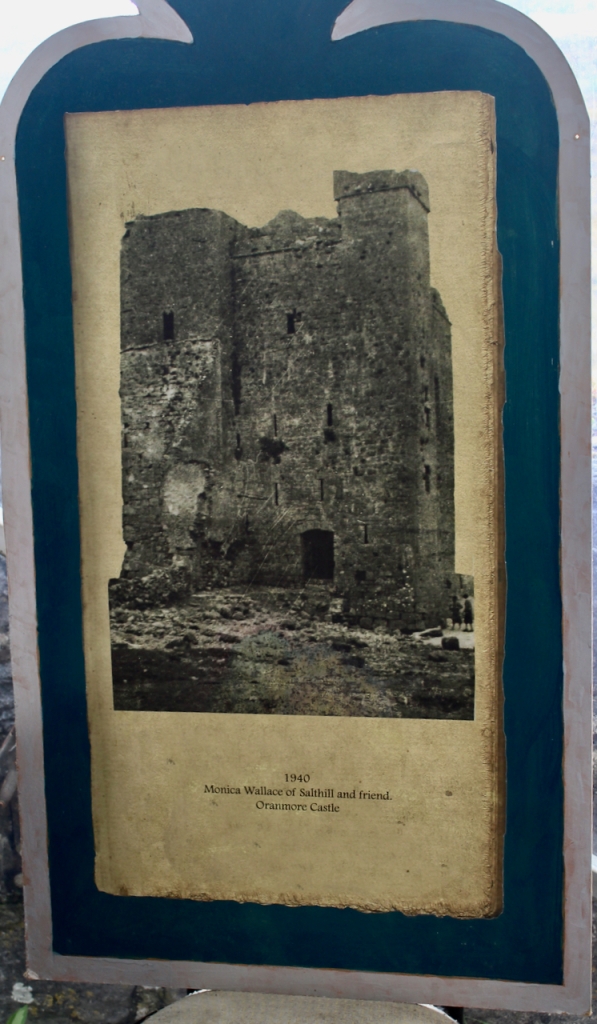
The website continues: “Oranmore Castle was built sometime round the fifteenth century possibly on the site of an older castle.
“It was a stronghold of the Clanricardes who were a prominent Norman family of Galway. [The castle was recorded as being occupied by the Earl of Clanricarde in 1574]. In 1641 Galway was under the overlordship of the Marquess and fifth Earl Clanricarde. In March 1642 the town revolted and joined the Confederates with the Fort (St Augustin’s) still holding out.“
“Clanricarde placed a strong garrison in Oranmore castle, from which he provisioned the Fort of Galway from the sea until 1643 when Captain Willoughby Governor of Galway surrendered both fort and castle without the Marquess’s consent. In 1651 the castle surrendered to the Parliamentary forces.”
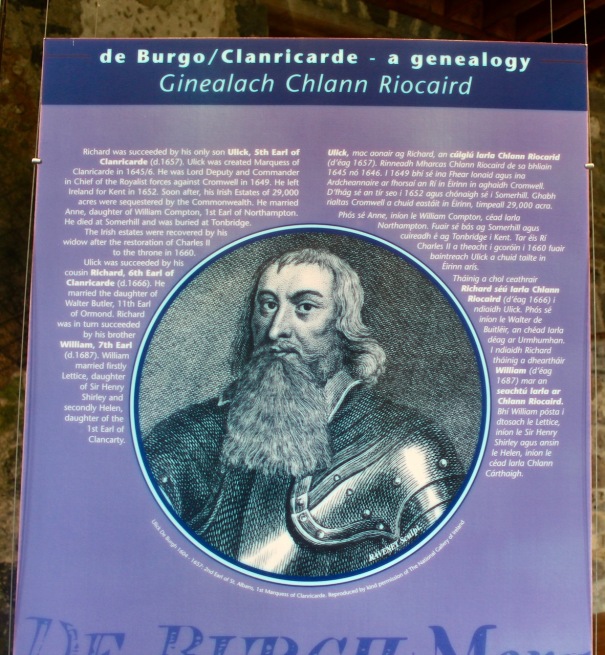
The 5th Earl of Clanricarde lived in Portumna Castle in County Galway. The town of Galway was held by the Confederates, who were mostly Catholic landowners. They wanted an end to anti-Catholic discrimination, and to have greater Irish self-governance. They were loyal to King Charles I, who was sympathetic to their cause. The Confederates formed their own parliament, in Kilkenny, and there was a period of Irish Catholic self-government between 1642 and 1649.
The Parliamentarians were supporters of Oliver Cromwell. Cromwell’s troops came to Ireland in 1649 to crush the alliance of the Confederates and the Royalists. Charles Coote, later 1st Earl of Mountrath, and his Parliamentarian troops fought the Confederates in Galway in 1651 and the town surrendered in 1652. The castles of both Oranmore and Claregalway were taken in 1651.

Hardiman’s History of Galway tells us: “The surrender [of Galway] was followed by a famine throughout the country, by which multitudes perished. This was again succeeded by a plague, which carried off thousands both in the town and the surrounding districts; so that the severest vengeance of heaven seemed now to have been poured down on the heads of this devoted community. Many, driven to despair by the severities inflicted upon them, instead of avoiding the pestilence, sought refuge in death from their merciless persecutors. This dreadful visitation continued for two years, during which upwards of one-third of the population of the province was swept away, and those who survived were doomed to undergo sufferings to which even death itself was preferable. Col. Stubbers, who was appointed military governor of the town upon its surrender, under pretence of taking up vagrants and idle persons, made frequent nightly excursions, with armed troops into the country, and seized upwards of a thousand people, often without discrimination of rank or condition, whom he transported to the West Indies, and there had sold as slaves.” [1]
The castle was restored to Richard Burke (c. 1610-1666), 6th Earl of Clanricarde in 1662 after King Charles II came to the throne. Many Catholics and Confederates were restored to their land after the restoration of the monarchy in 1661.
The website continues: “In 1666 he leased the castle to Walter Athy. Mary, Walter’s daughter married secondly [her first husband, a Mr. French, had died] Walter Blake [c. 1670-1740] of Drumacrina Co Mayo, and her descendants by that marriage held Oranmore until 1853, when the estates of Walter Blake were sold to the Encumbered Estates Court.“
Mary and Walter had a son, the exotically named Xaverius J. A. Blake. Their daughter Anne married Patrick D’Arcy of Kiltullagh, County Galway (now a ruin, unfortunately). The Blake family built a large house against the south side of the castle, but this was later demolished.
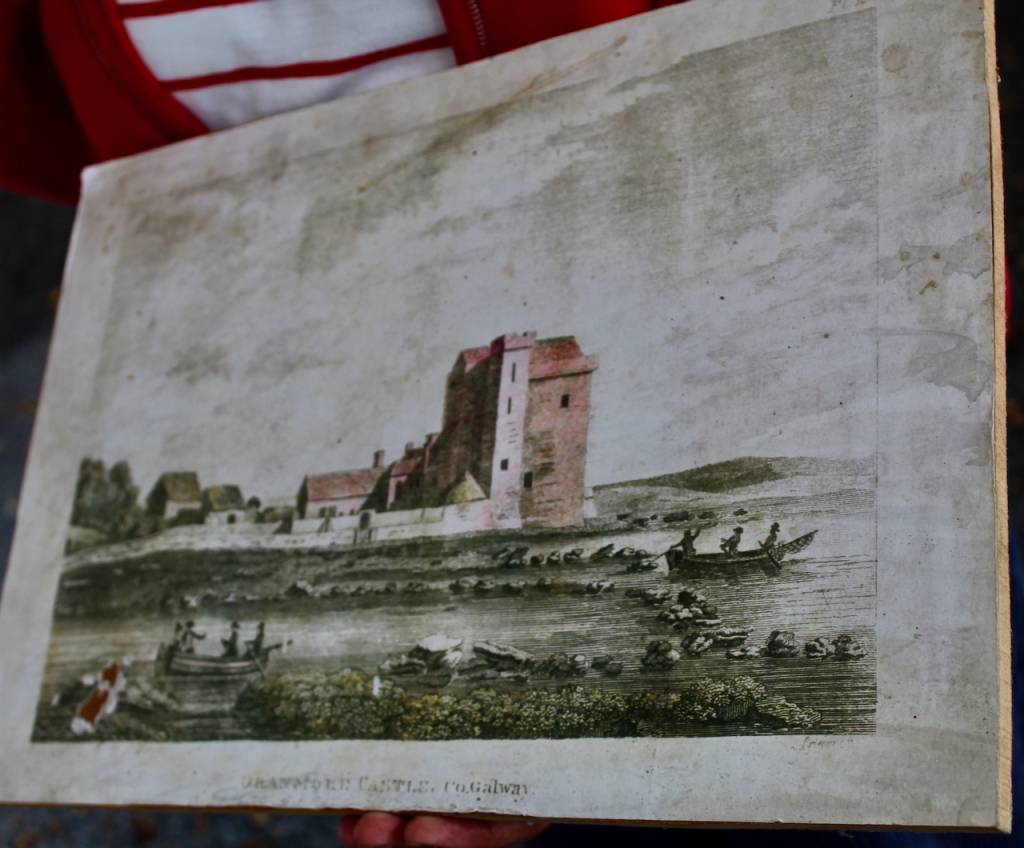
Xaverius (d. 1768) married a daughter of Charles Daly of Callow, County Galway, and had at least two sons, Walter (d. 1757) and Andrew (d. 1770). Walter married Bridget Daly, daughter of Denis Daly of Raford, County Galway (the house now at Raford, built by Francis Bindon, was built after they married but still stands, a beautiful three storey over basement house. It was advertised for sale in 2009). The other son, Andrew, died without any children. [2]
Walter Blake (d. 1757) and Bridget had a son, Xaverius (1752-1784). The Peerage website tell us that on his majority, Xaverius entered into possession of a rent-roll of £5,500 a year, together with £100,000 in ready money which had accumulated during his 16 year minority. With his wife he embarked on a career of such extravagance that by his death the greater part of the inheritance had been dissipated. He lived at Dunmacrina (or is it Drumacrina?), County Mayo, Ireland, and at Oranmore Castle. He married Isabella Knox, heiress to the Knox diamonds. Her father John Knox went by the nickname “Diamond” Knox, and he lived in Castlerea, County Roscommon. He was called “Diamond” Knox because of the large dowry which he gave his daughter Isabella, along with a large suite of diamonds, David Hicks tells us. [3] Diamond Knox marred Anne King, daughter of Henry King of Rockingham, County Roscommon. Upon Xaverius’s death there followed by lengthy litigation regarding the ownership of the Knox Diamonds, which was not settled until nearly a century later.
Isabella married again after Xaverius died, to Andrew Blake of Castlegrove, County Galway (the house is now a ruin).
Xaverius and Isabella had several children. Their son Walter Arthur Blake (d. 1836) lived at Drumacrina and Oranmore. He fought in the Irish Rebellion in 1798, for which he raised, equipped and maintained at his own expense a corps of Yeomen Cavalry in the King’s service. He held the office of Justice of the Peace. He married Mary Butler of County Clare, and they had a son, another Xaverius (d. 1838).
The Landed Estates database tells us that in 1786 Wilson mentions Oranmore as the seat of Denis Blake. He was a brother of Xaverius (1752-1784). In 1814 and again in 1837 Oranmore Castle is recorded as the seat of Walter Blake. At the time of Griffith’s Valuation he was leasing a property, valued at £10, in Oranmore townland, to Martin Grady. [4]
Xaverius (d. 1838) married Ellis Ussher, daughter of Christopher Ussher of Eastwell, County Galway. It was their son, Walter Augustus Blake (d. 1858) who sold Oranmore Castle to pay his debts in 1853.
The Landed Estates database tells us that Pádraig Lane writes that Walter Blake sold “Oran Castle” to James Dillon Meldon, a Dublin lawyer. [5] The Stillorgan History website tells us that James (1803-1883) was an agent to the Commission of Bankruptcy, with chambers at 16 Upper Ormond Quay and a solicitor of Casino, Milltown/Dundrum and Glencorrib, Mayo. He married Bedelia Louisa Ingram, daughter of John Ingham, Solicitor of Johnville, Cavan. He purchased land in Belmont near Tuam and restored it to the former tenants. He advanced them with money for farm implements, seed and horses with the help of his agent Thomas Jackson. He was a generous supporter of Dublin charities and he worked pro bono for the Sick and Indigent hotel and Inn
keepers charity. Their town house was 16 Fitzwilliam street and by 1873 they were at 24 Merrion Square. [6] This website doesn’t mention his ownership of Oranmore.
The website continues: “This house was left in ruins when the Blake family left Oranmore and the castle was un-roofed until 1947 when it was bought by Lady Leslie, a cousin of Churchill and wife of Sir Shane Leslie the writer.“
We came across Shane Leslie (1885-1971), 3rd Baronet of Glaslough, County Monaghan and his wife Marjorie Ide in Castle Leslie, see my entry. [7]

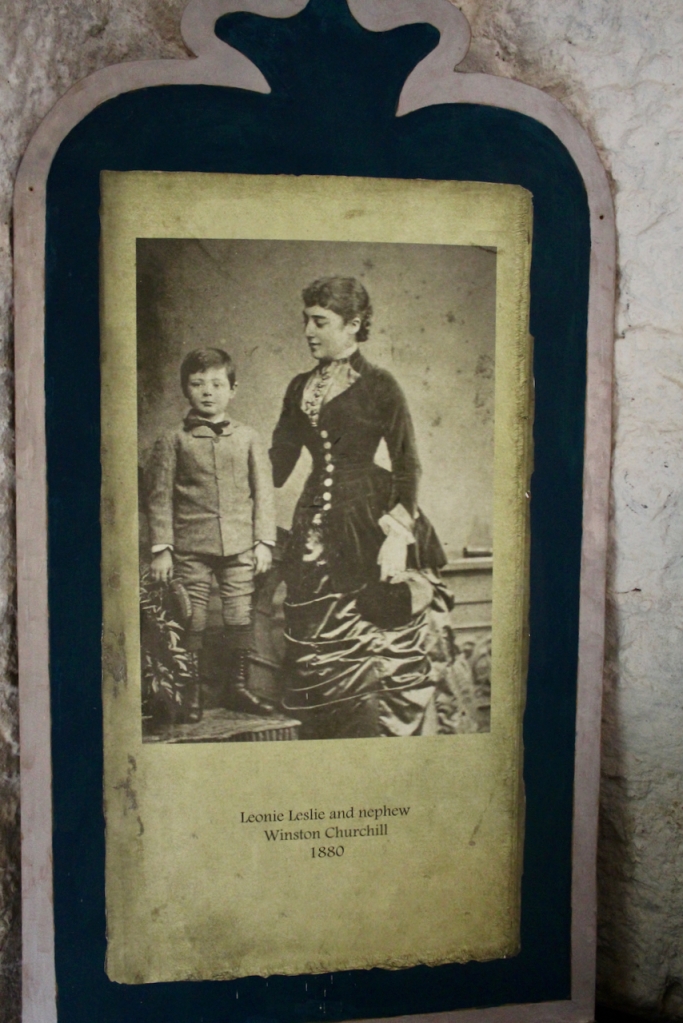


Lady Leslie purchased the property for her daughter, Anita – whom we also came across in Castle Leslie.
The tour guide showed us a copy of a letter which was sent to Leonie telling the story about how her mother purchased the castle. She must have been quite a character, the purchase seems quite impulsive! A leaflet from Oranmore tells us that Leonie Leslie was travelling around the west coast of Ireland with her friend Oliver St. John Gogarty. He had persuaded another American woman, Mrs Watson, to buy the castle from the Land Commission. Leonie Leslie then purchased it from Mrs Watson.
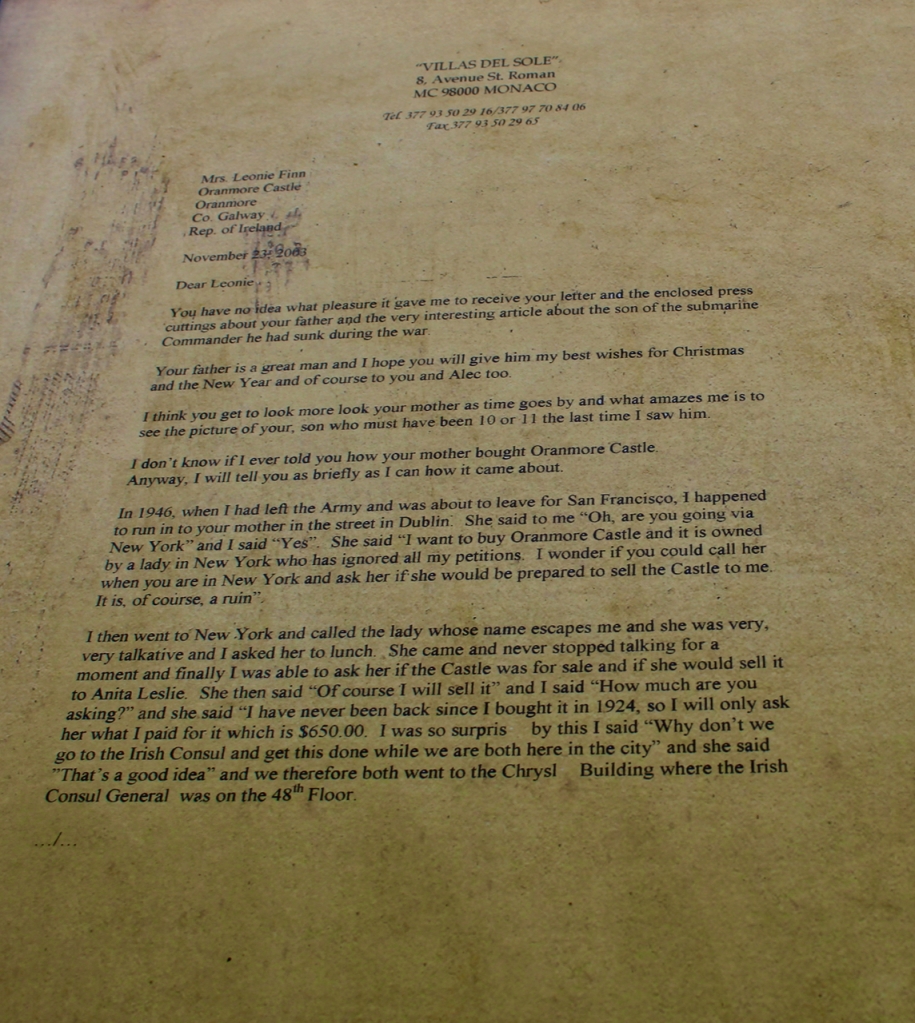

Anita Leslie had a very interesting life. She was an ambulance driver for five years in Egypt, Italy and France. She had been married first to a soldier from Russia, who had tried to save the Romanov family (see my entry for Castle Leslie). Secondly she married Bill King.

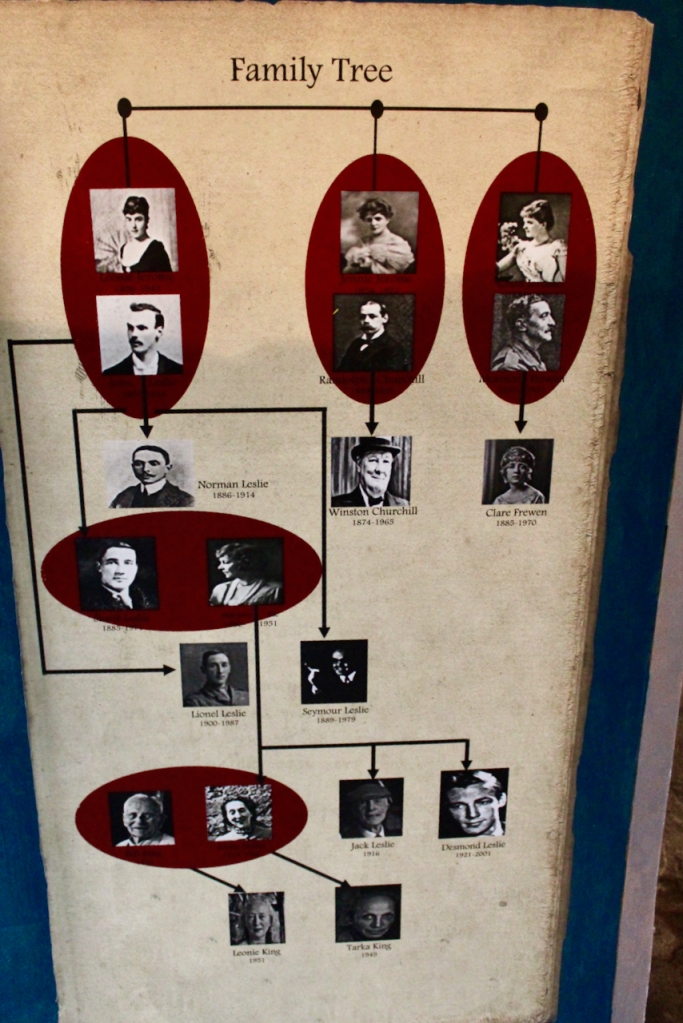
The website tells us that Lady Leslie re-roofed the castle and gave it to her daughter. She was certainly brave to take on such a dilapidated tower house! A cousin of Shane Leslie, Clare Sheridan, purchased the Spanish Arch in Galway around the same time. Lady Leslie discussed designing a roof for the castle with the County Engineer. Eventually he drew up plans for a cement roof, to be covered in asphalt.
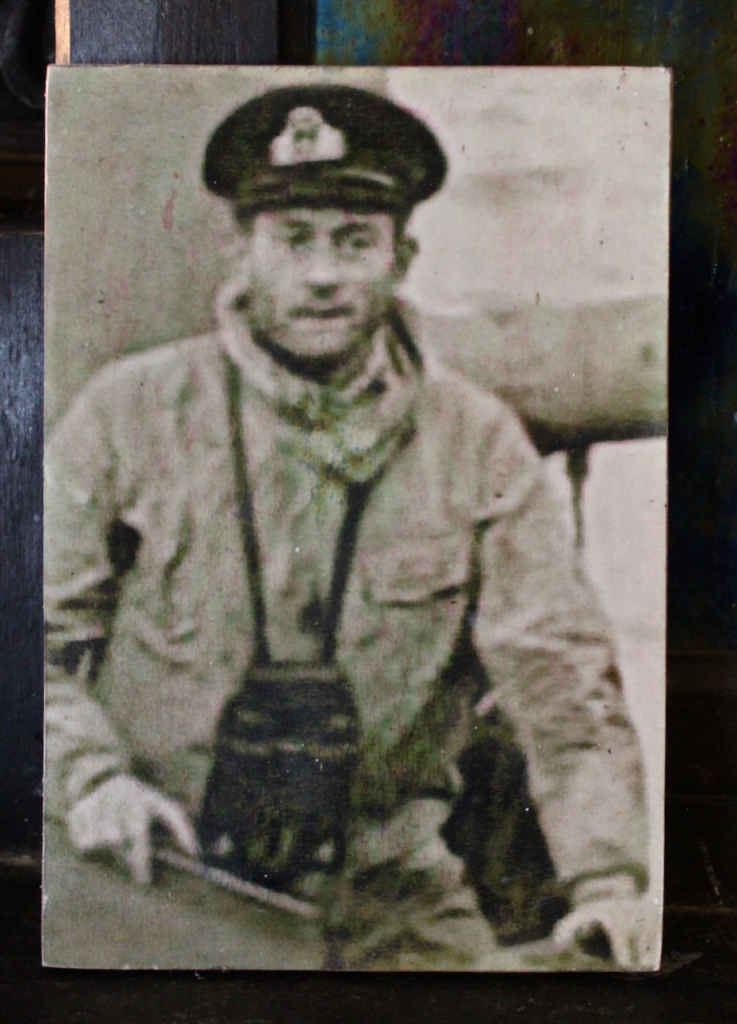

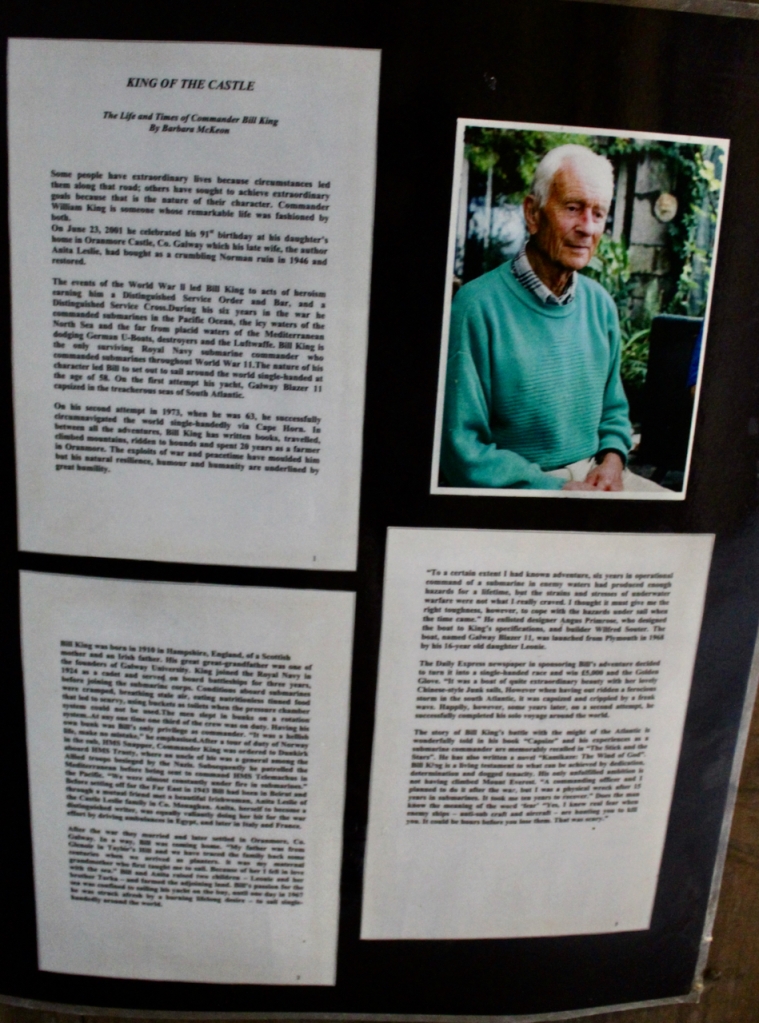
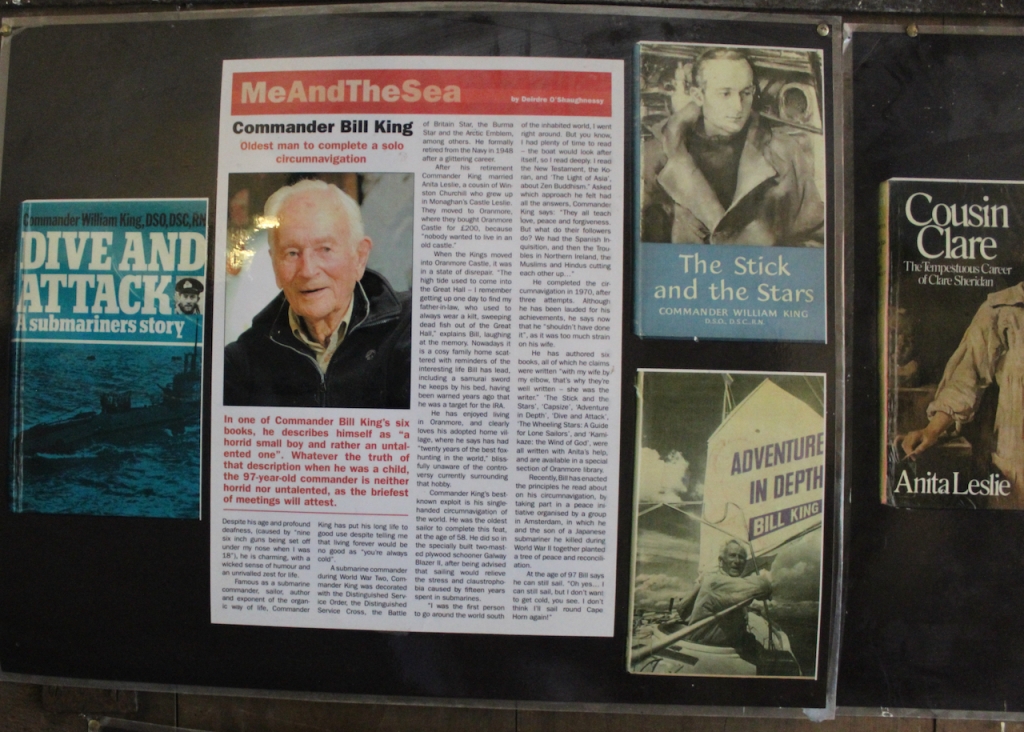
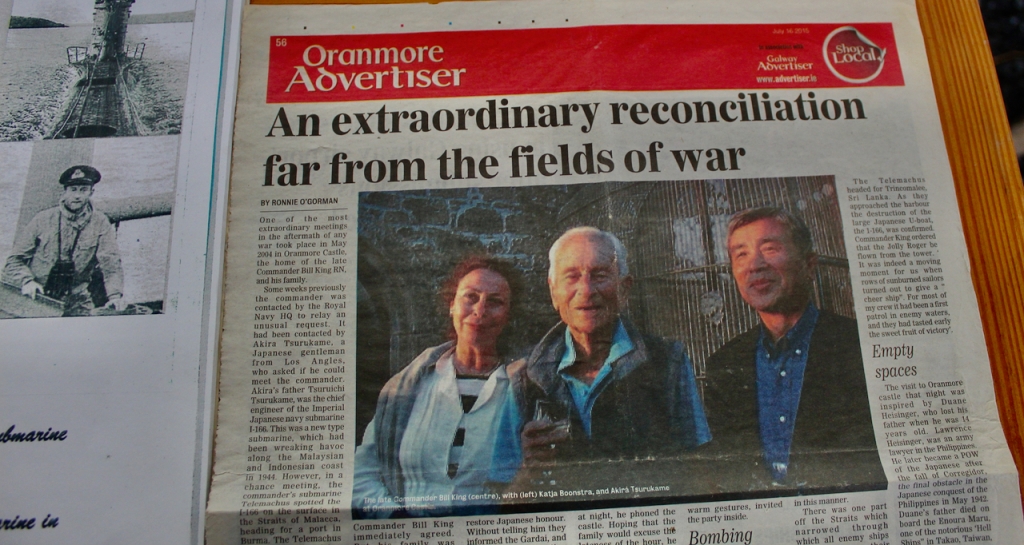
The website tells us that between 1950 and 1960, Anita and her husband, Cmdr Bill King (also a writer who sailed solo around the world in 1970) added a two storey wing joined to the castle by a single storey range. A nursery and bathroom was first added when a baby was born. Ten years later, stone from a small Protestant church which was being demolished was purchased and used to build the second small tower, with the help of Michael Richardson. At the time of our visit, the castle was occupied by artist Leonie King (daughter of Anita Leslie and Bill King) and her husband Alec Finn of the music band De Danaan.
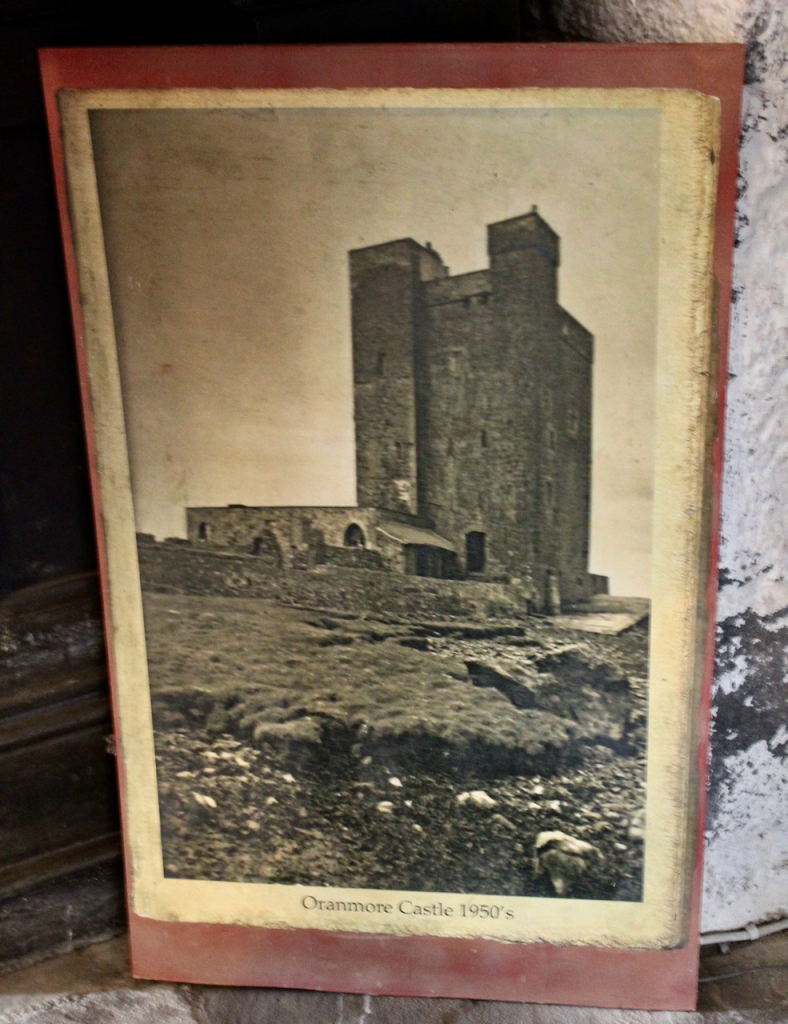
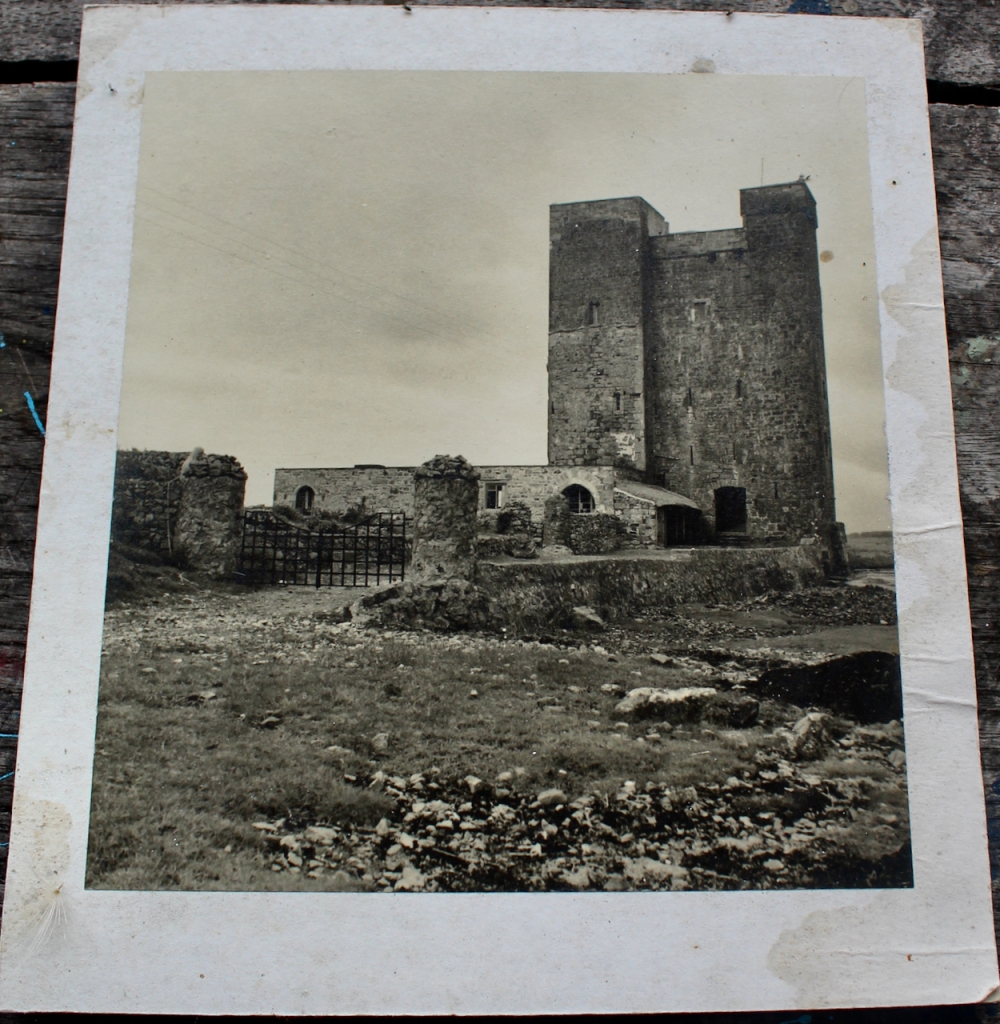
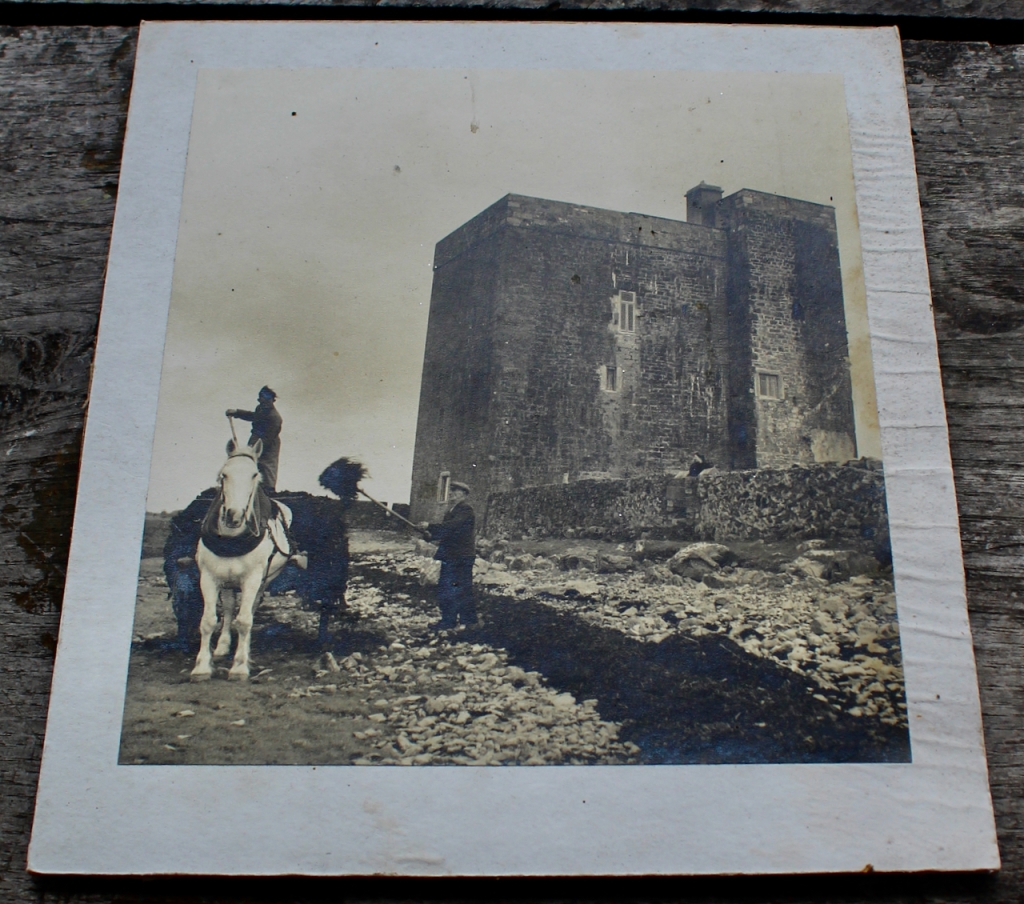
There was a marquis attached to the front of the castle for a Heritage Week event.
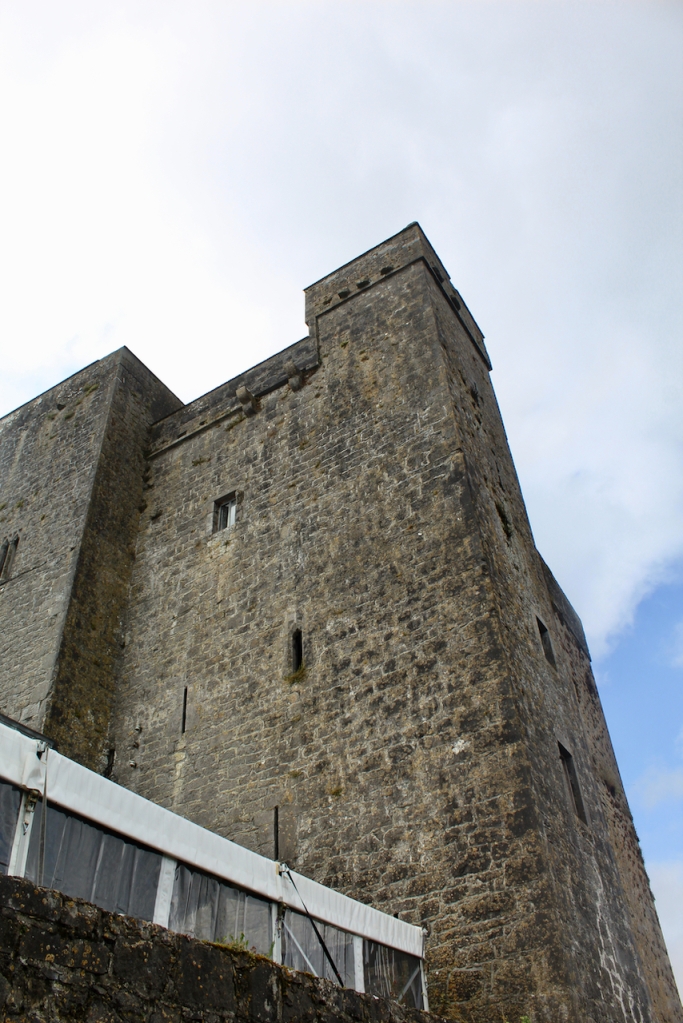

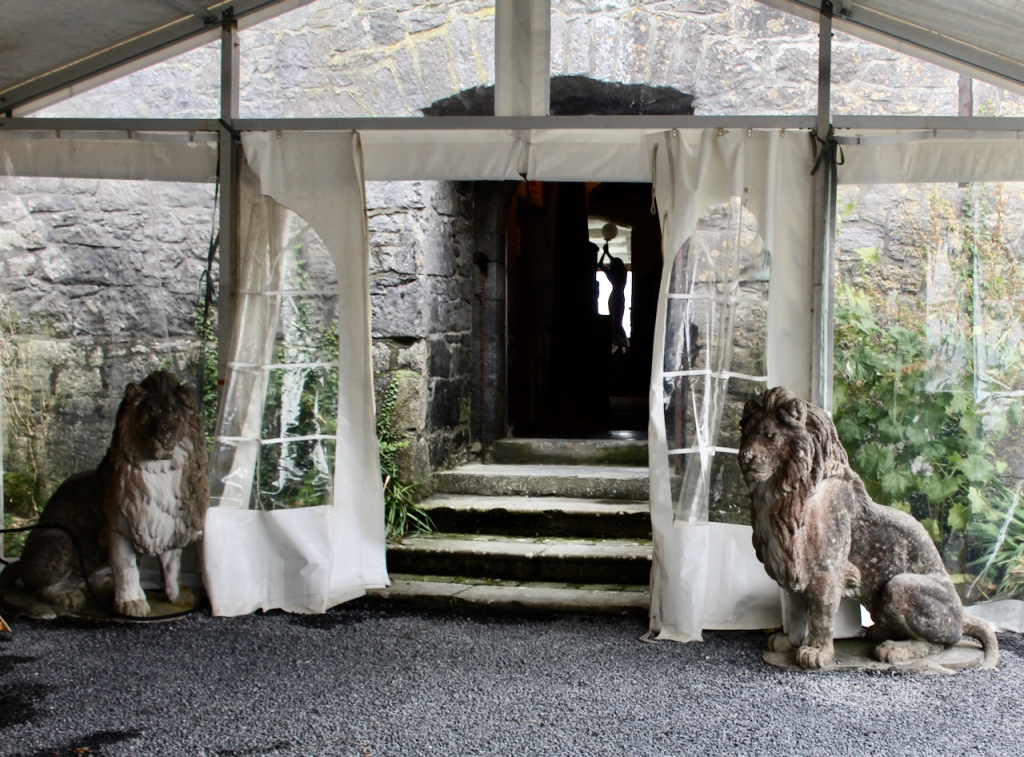
Through the front door, one steps into the large vaulted chamber. It is difficult to capture in a photograph. The castle is a treasure trove of objects and furniture from around the world, and its inhabitants must be creative and artistic. Unfortunately we did not get to meet the owners.


The fireplace was carved by Michael Richardson from Moycullen.


The poster of the Irish Tower House shows a tower house much like Oranmore. We can see the vaulted ceiling, and the way there may have been many floors below the vault. It explains that the mortared vaults were built directly on top of a wattle or wicker-work screen supported by a timber frame. When the frame was removed the wattle was left attached to the mortar and was over plastered over. Today the impression of the woven wattle screens can be seen on the underside of many of these vaults, as we can see on the ceiling in Oranmore. We also saw this effect in St. Mary’s Abbey house in Trim, County Meath (see my entry).
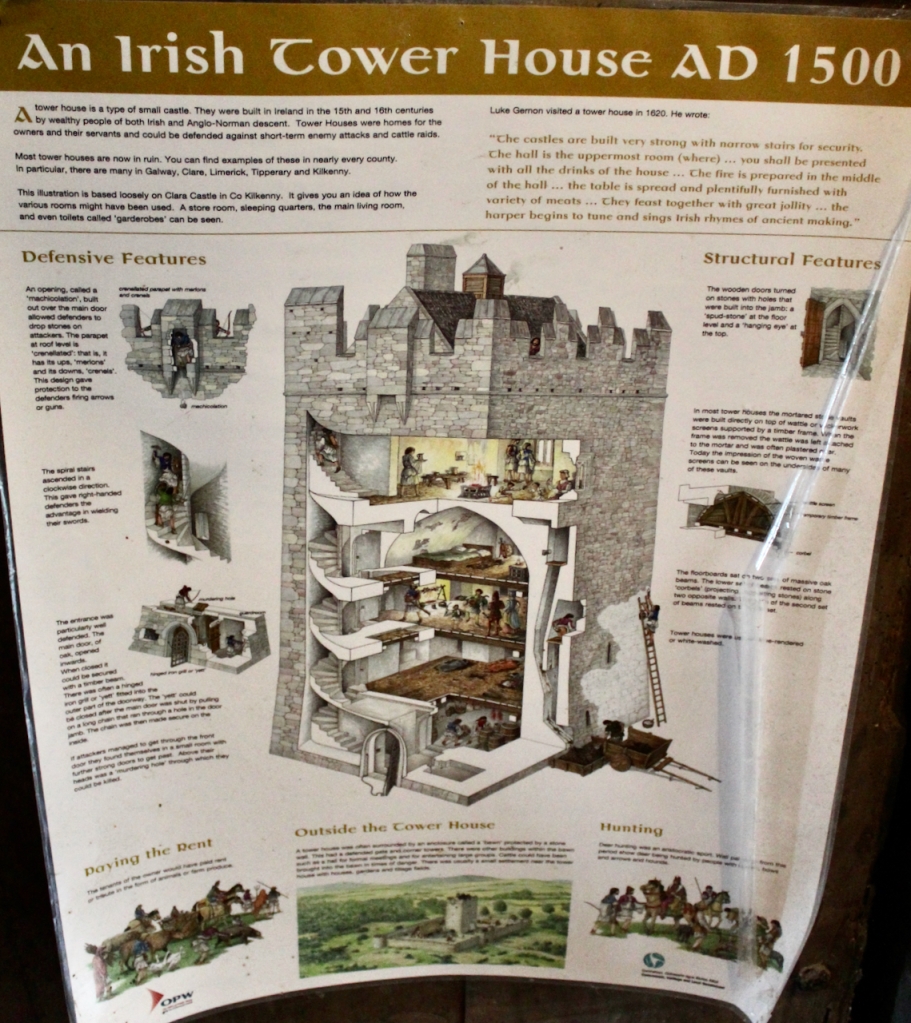







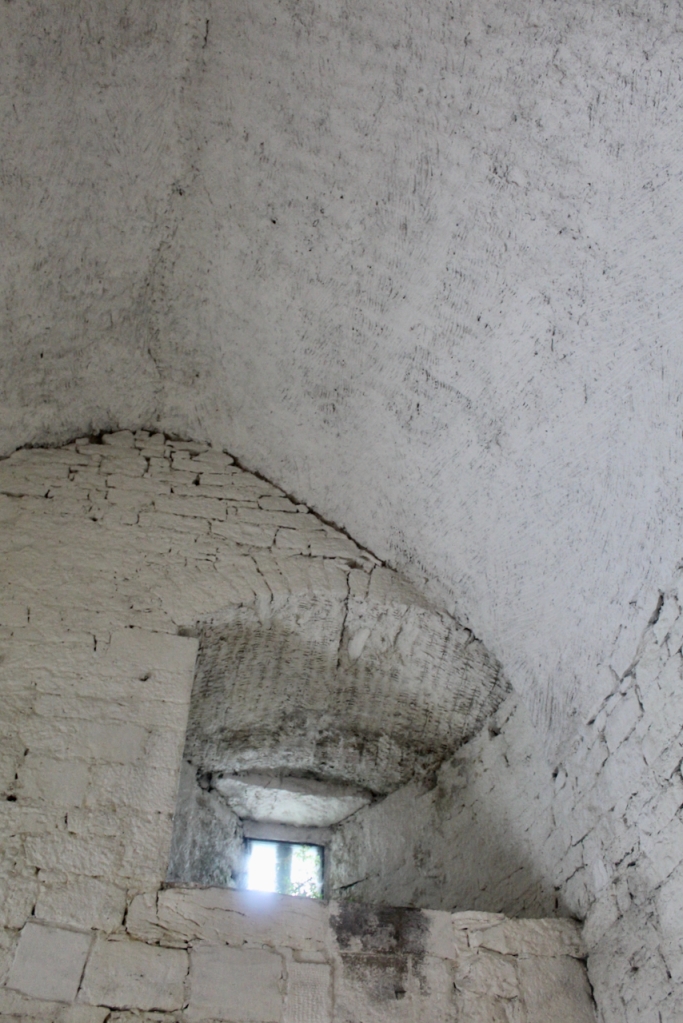
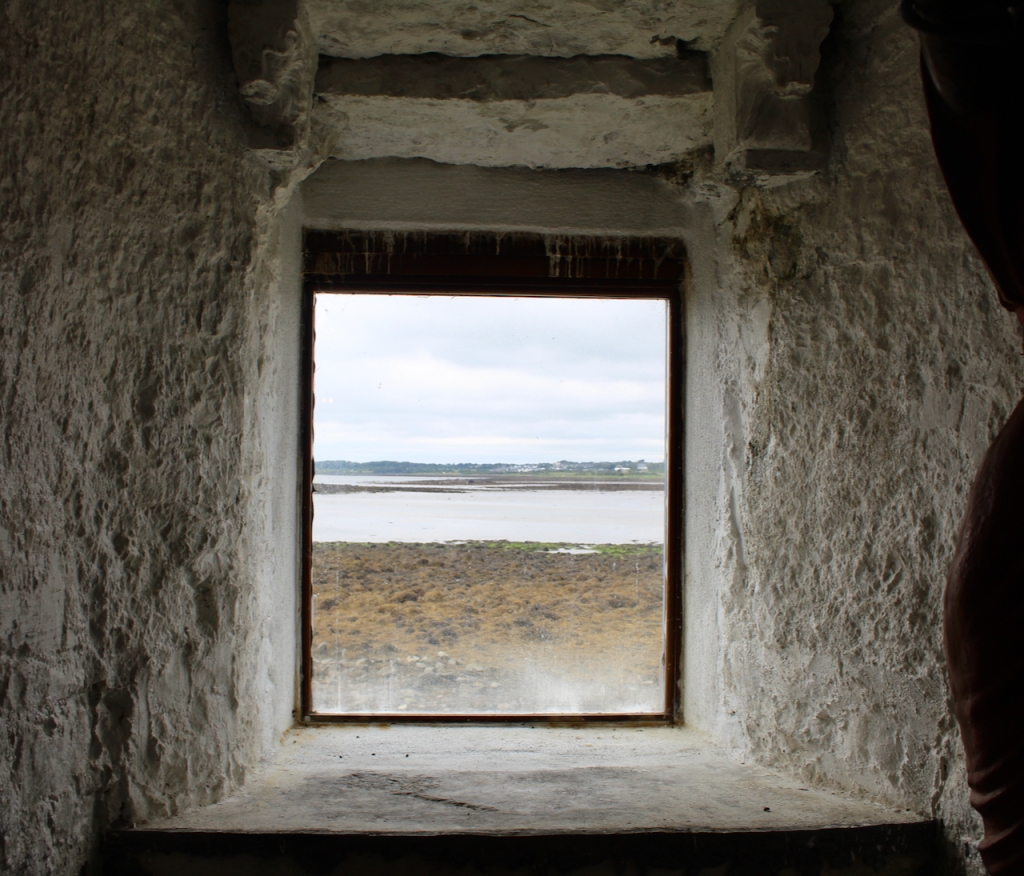

We did not get to see upstairs unfortunately, so I have to make do with photographs of the upstairs which were on display.

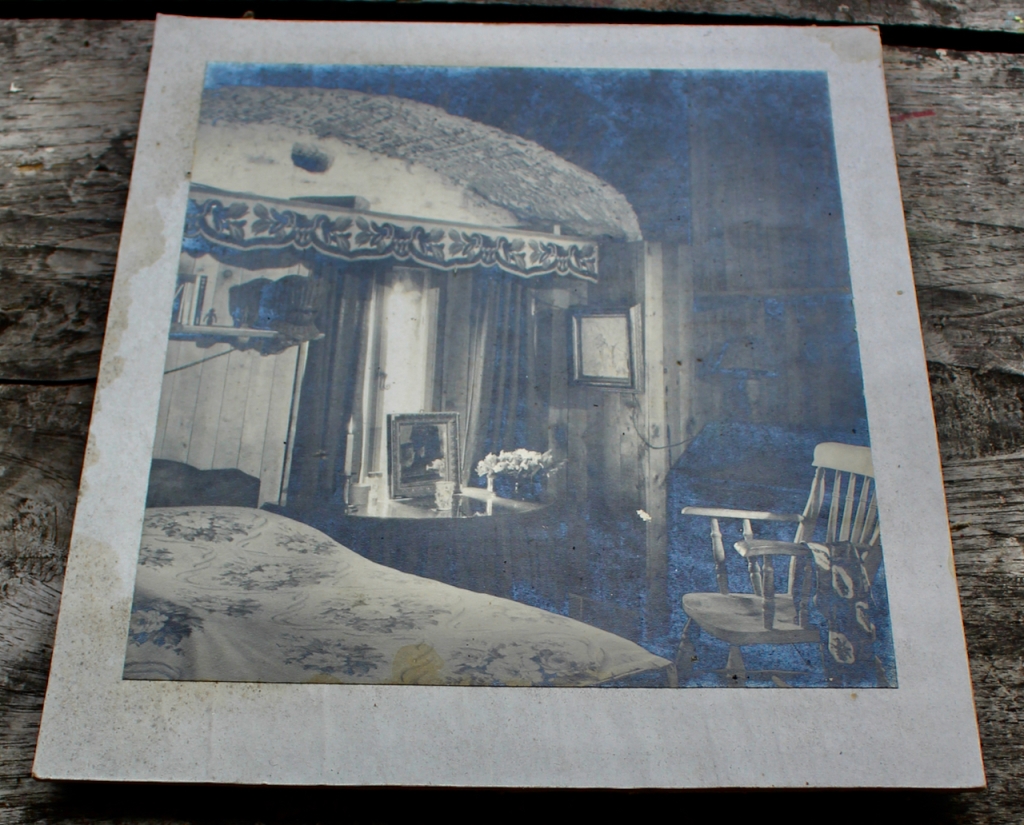

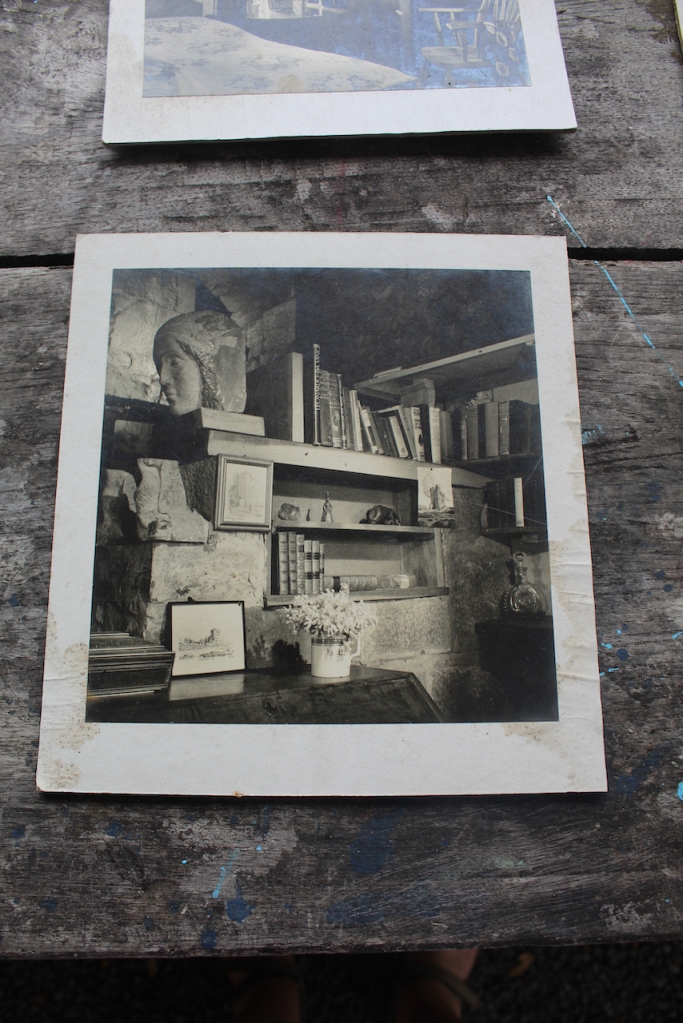
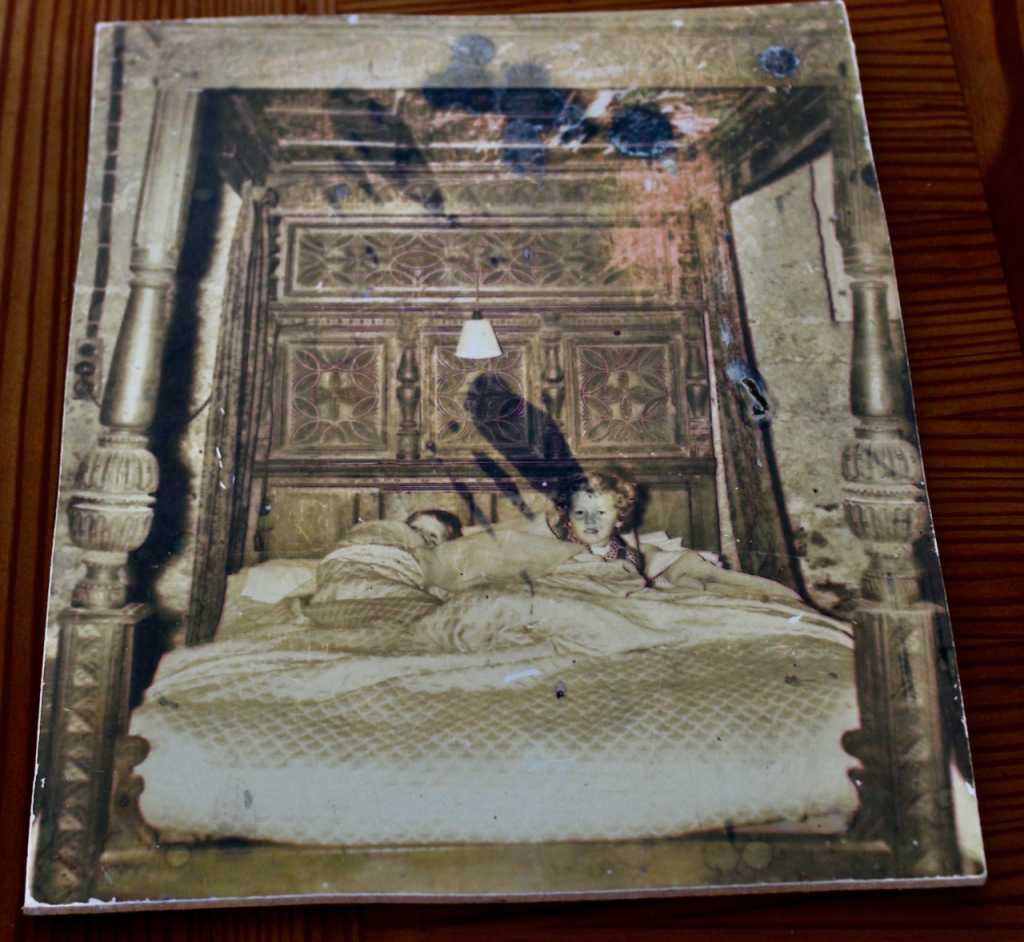
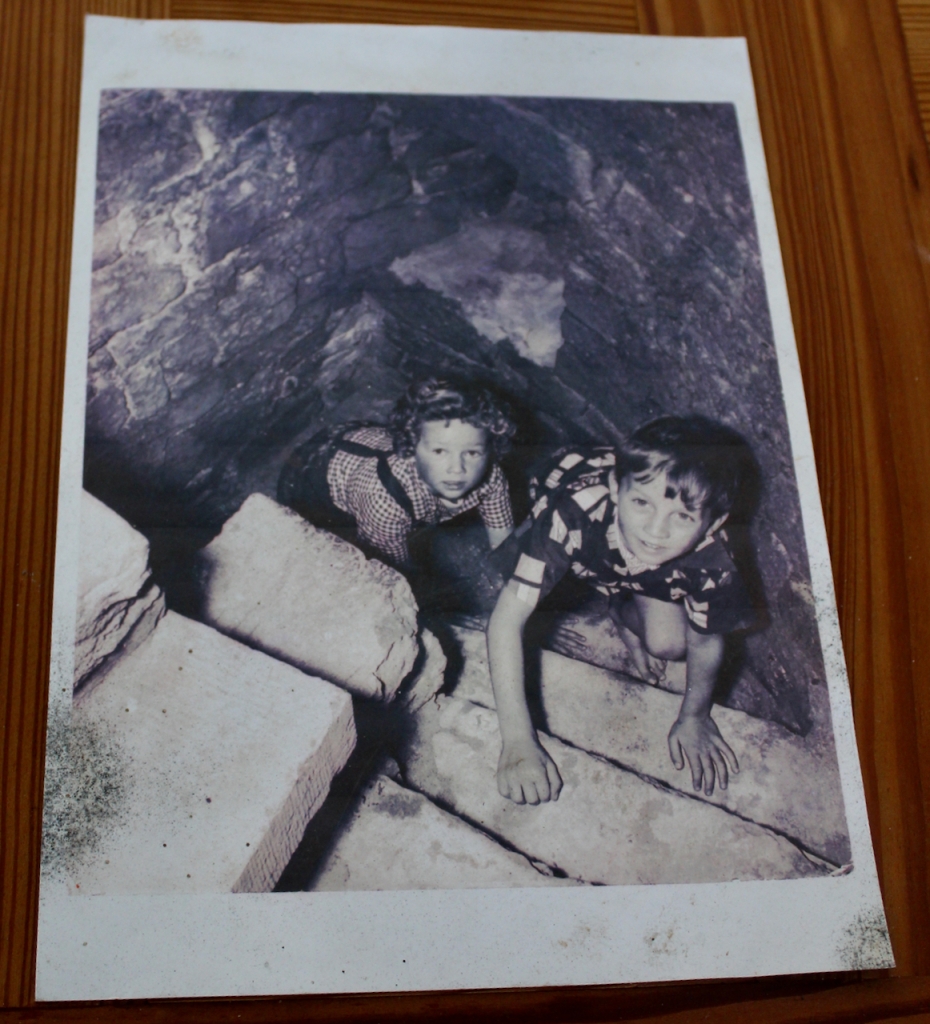
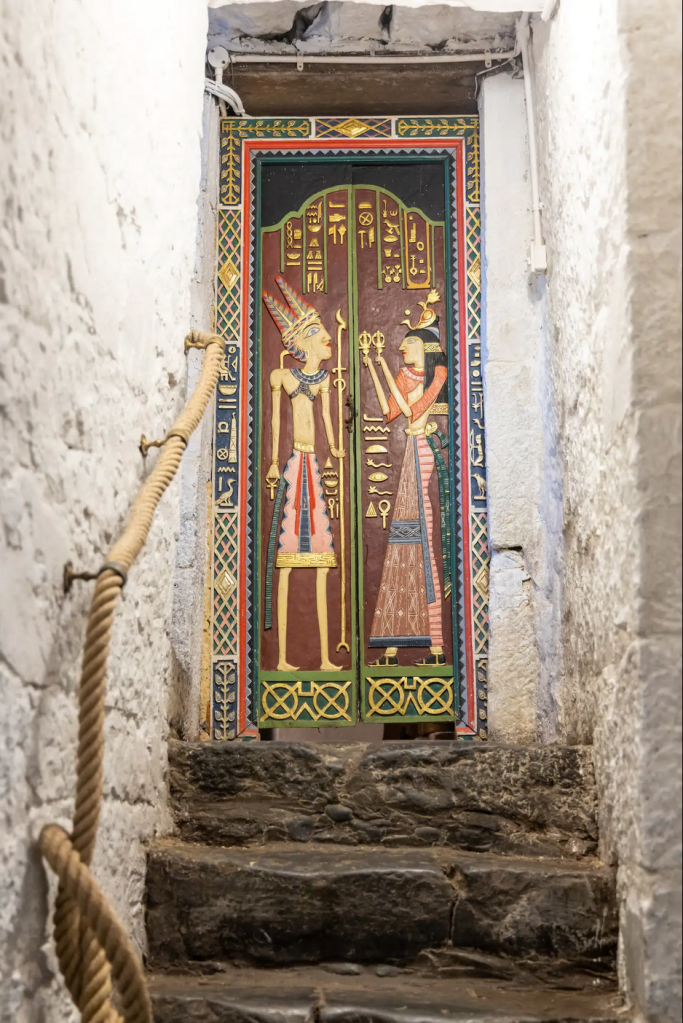
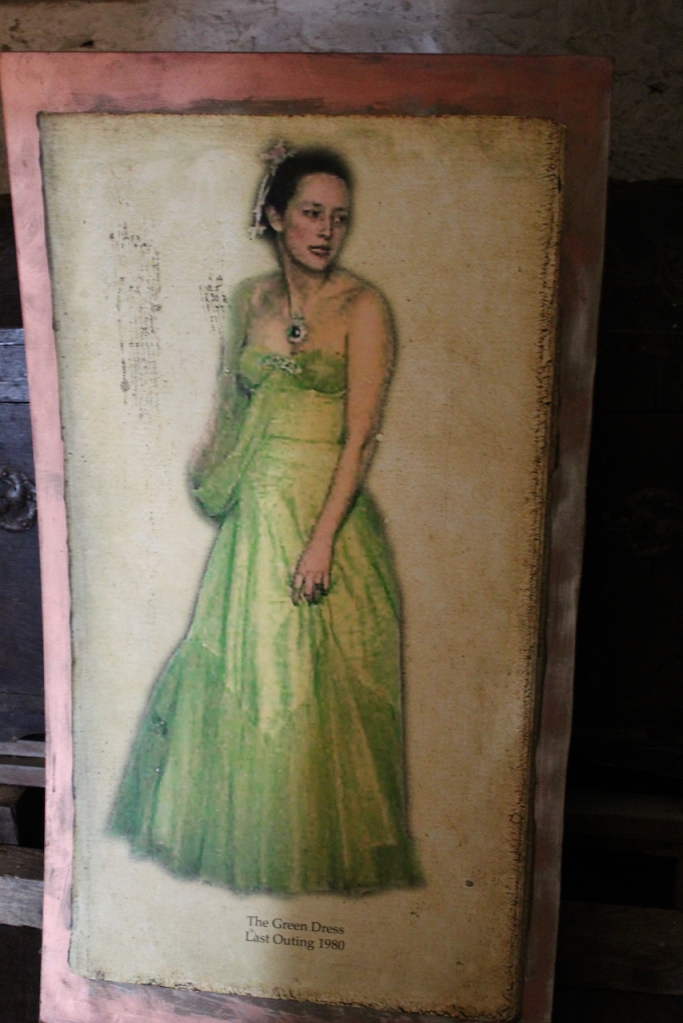
Another fascinating person in the extended Leslie family is Clare Sheridan, née Frewin. She was a sculptor and writer. Her mother was the third Jerome sister, i.e. sister of Jennie Jerome mother of Winston Churchill.
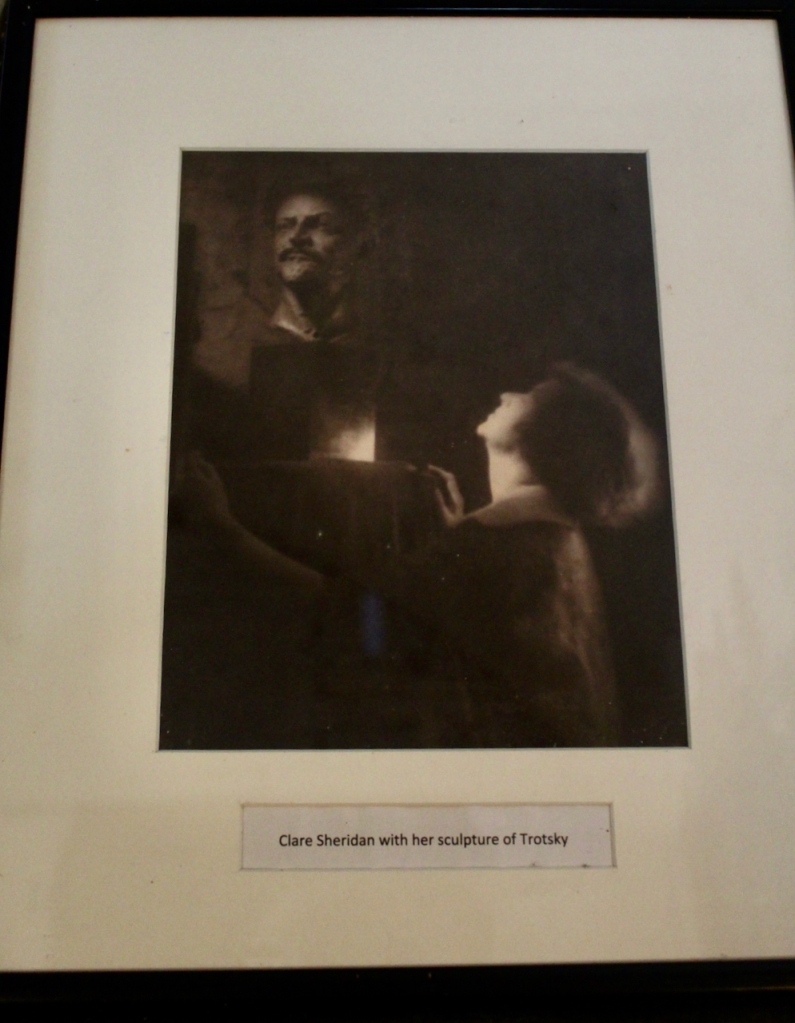
You can stay in Oranmore Castle! It is on airbnb, https://www.airbnb.ie/rooms/750577721156942923?guests=1&adults=1&s=67&unique_share_id=df41c7c7-440c-4254-bb64-bcc281c67e14&source_impression_id=p3_1679423724_hQHjy8%2B%2F767VgiM0&modal=PHOTO_TOUR_SCROLLABLE
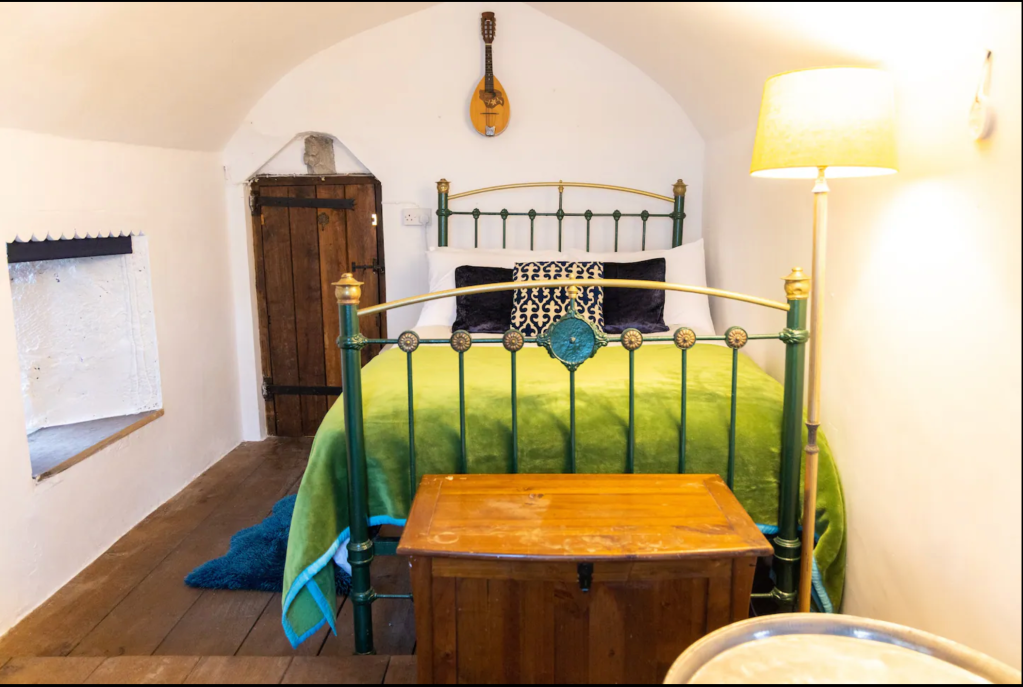
[1] http://www.galway.net/galwayguide/history/hardiman/chapter5/coote.html
[2] Blake family records, 1600 to 1700; a chronological catalogue with notes, appendices, and the genealogies of many branches, of the Blake family, together with a brief account of the fourteen ancient families of tribes of the town of Galway, and a description of the corporate arms used by that town at different periods; with an index to the records in the first part. Illustrated with photographs of various original documents and seals. 2d series. https://archive.org/stream/blakefamilyrecor00blakuoft/blakefamilyrecor00blakuoft_djvu.txt
[3] http://davidhicksbook.blogspot.com/2016/08/castlereagh-killala-co.html
[4] http://landedestates.nuigalway.ie/LandedEstates/jsp/property-list.jsp?letter=O
[5] https://landedestates.ie/estate/579
[6] https://www.youwho.ie/meldon.html
[7] https://irishhistorichouses.com/2020/08/07/castle-leslie-glaslough-county-monaghan/
Hi Jenny, I remember hangin out in the castle when Finn & Leone lived there. Lots of heavy jumpers needed to get by. My school pal Niall married their daughter, and now he lives there.
LikeLike
Oh wow! I was sad to hear that Alec died.
LikeLike